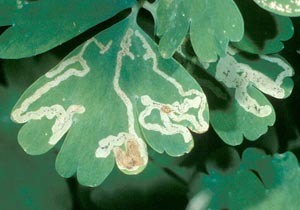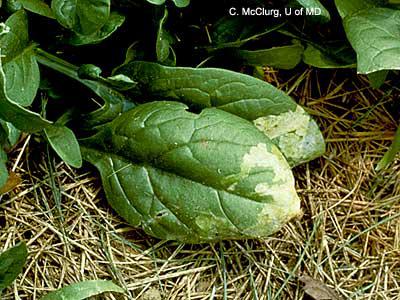Leafminers -– The Tunneling Insects
By Pat Dickey, Fairfax Master Gardener
 Have you noticed unusual, meandering trails or round blotches on the leaves of your perennials and vegetables or on your trees and shrubs? These tunnels or mines are the work of larvae and other immature forms of leafminers. They tunnel between a leaf’s top and bottom layers, where they feed on the soft tissue and avoid the tough, outer layer. Adults are small flies, moths or beetles. There are several types of leafminers, each favoring different plant species. Here are some varieties of leafminers common to our area.
Have you noticed unusual, meandering trails or round blotches on the leaves of your perennials and vegetables or on your trees and shrubs? These tunnels or mines are the work of larvae and other immature forms of leafminers. They tunnel between a leaf’s top and bottom layers, where they feed on the soft tissue and avoid the tough, outer layer. Adults are small flies, moths or beetles. There are several types of leafminers, each favoring different plant species. Here are some varieties of leafminers common to our area.
Herbaceous perennials
Small fly larvae (Agromyzidae) infest many perennials during their growing season, particularly columbine, perennial sunflowers, daisies and veronica. The female leafminer lays eggs in the leaf and upon hatching, the larvae feed on the inner leaf tissue, creating serpentine mines. The damage affects the appearance of the plants but is rarely serious. Monitor plants throughout the season for mining, especially on columbine. When you see a mine, press the area between your fingers to kill the larva. Then remove and dispose of the damaged leaves.

Leafminer adult fly
Vegetable plants
Pegomya hyoscyami, the spinach leafminer, attacks Swiss chard and beets, as well as spinach. Leaves can become inedible, and the plants are unable to support further root development. The leafminer pupae overwinter in the soil, and the adults emerge in late April or May. They are tiny black flies with yellow markings, abdominal stripes and transparent wings. Females lay eggs on the underside of leaves, and in 3 to 4 days the larvae hatch and burrow into the leaves creating serpentine mines while feeding. The developing maggots can enter adjacent plants and damage whole rows of crops. There can be up to three generations of flies each season, especially in mid- to late May, late June and mid-August.
The vegetable leafminer, Liriomyza sativae, feeds on the leaves and soft stems of beans, cantalope, celery, cucumbers, eggplant, onion, pepper, potato, tomato and watermelon. It is similar in appearance and behavior to the spinach leafminer.

Leafminer damage on Spinach
To prevent leafminer damage, rotate crops and use floating row covers over seeded areas and transplants before flies emerge. Maintain a weed-free garden bed and continue to look for and crush egg masses. Remove all host weed species of the leafminer from the garden area, including chickweed, lambsquarters, nightshade and plantain. Add flowering nectar- and pollen-rich plants to attract beneficial parasitic wasps. Cultivate the garden in late fall to expose pupae to colder temperatures that will kill them. Use neem oil or spinosad if needed on large infestations, but take care not to kill beneficial insects or bees.
Shrubs
Caloptilia azaleella, the azalea leafminer, emerges as a small purple and yellow adult moth when azaleas flower in the spring. Populations overwinter as pupae in rolled leaves or as larvae in mined leaves. Prune out infested branches and destroy. Add plants that will attract beneficial parasitic wasps. If necessary, apply an approved pesticide treatment in mid- to late May when mines are first seen.
Boxwood leafminers, Monarthropalpus flavus, are extremely destructive to boxwoods. Small mosquito-like adult flies appear in late April or early May during 10-14 days. Females lay eggs in new leaves, and the larvae hatch after 3 weeks. The larvae feed inside the leaves from June until early fall, spend the winter inside the leaves, and pupate in April to complete their life cycle. The boxwood leaves will look blistered with blotch-shaped mines while the larvae are inside. Healthy plants will be able to withstand this damage. Prune and destroy all infested branches. Buxus sempervirens varieties are more resistant. For heavy infestations, treat boxwoods with a recommended pesticide when you see active flies and before eggs are laid.
Trees
Caterpillars (larvae) of Argyresthia spp., the arborvitae leafminer, tunnel into the tips of the foliage, causing them to turn yellow then brown in spring and fall. They are green with reddish and black heads and complete their entire development inside the arborvitae leaves. You will need to break open the shrub’s tips to find them and their tunnels and frass. Prune the infested tips and destroy them. Small light tan moth adults will emerge by shaking the foliage in June and July. Insecticides may be applied in June to control large outbreaks.
The holly leafminers, Phytomyza sp., infest both American and European holly trees. Tiny yellow fly adults are active mid-May. The mining damage is done by the maggots of tiny yellow flies. Maggots begin mines as narrow tunnels and by fall, they look like dark streaks. Adult females cause other damage by puncturing the holly leaves with their ovipositors, and the adults feed on the juices. American hollies are more susceptible when stressed or grown in full sun. To prevent further damage, collect fallen leaves and destroy them. Hand pick leaves in light infestations. Plant resistant varieties such as ‘princess’ or ‘blue princess.’ Treating adults with recommended pesticides in mid-May will reduce the feeding punctures but not the mines.
Odontota dorsalis, the locust leafminer, is a small yellow and black beetle that feeds on the black locust tree, and occasionally, apple, birch, beech, cherry, elm, oak, hawthorn and dogwood trees. The adult beetles are pests as well as their larvae. The beetles overwinter in the crevices of the bark. They emerge when the black locust leafs out in the spring and chew holes in the leaves. They then skeletonize lower leaf surfaces and lay eggs there. After hatching, the larvae bore holes into the leaves and feed in mines. The beetles and their larvae can so heavily attack the trees that they appear scorched and drop their leaves. They attempt to refoliate in the summer. If other poor conditions or drought have also stressed them, the trees may die.
Cameraria spp, the oak blotch leafminer, is a native moth that attacks scrub, post, black, red and mostly white oaks. Larvae feed just below upper leaf surface and create blotch mines. Rake and destroy all infected leaves in the fall. Apply controls when mines are first seen if needed.
References
Spinach Leafminer and Sowbug Damage, University of Maryland Extension
Leafminers – Trees and Shrubs, University of Maryland Extension
Leafminers, Penn State University Extension
…updated 2021